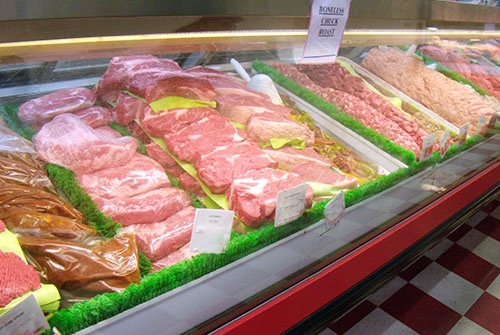Bagley Farms Meat Market Edwardsville IL: Your Relied On Source for High-Quality Meats
Bagley Farms Meat Market Edwardsville IL: Your Relied On Source for High-Quality Meats
Blog Article
Discover the Finest Option of Cuts From Local Meat Market
In an era where the beginnings of our food are extra significant than ever, discovering the finest selection of cuts from your regional meat market provides an engaging story of top quality and integrity. These markets not just guarantee unrivaled quality and preference however additionally provide insights right into the subtleties of various primitive and sub-primal cuts.
Advantages of Neighborhood Meat Markets
Local meat markets supply numerous benefits that are coming to be progressively significant in today's food landscape. Due to the fact that the supply chain is much shorter, local meat does not withstand extensive transport times, preserving its quality and nutritional worth.
Moreover, regional meat markets often sustain lasting farming methods. Several local manufacturers take part in eco-friendly and ethical farming methods, which add to the health of pets and the conservation of natural resources. By choosing to purchase from these markets, customers can play a function in promoting lasting farming and decreasing their carbon footprint.
In addition, regional meat markets add to the financial vitality of areas. By supporting neighborhood producers, customers assist sustain little companies and foster economic development within their area. This financial assistance can bring about work development and assistance preserve the one-of-a-kind character of local neighborhoods.
Recognizing Various Meat Cuts
A fundamental element of making educated investing in decisions at neighborhood meat markets is understanding the numerous cuts of meat offered. Largely, meat is categorized right into primal, sub-primal, and retail cuts.
For circumstances, from the beef primitive cut, the loin, one can obtain sub-primal cuts like tenderloin, leading to retail options such as filet mignon. The rib primal cut consists of sub-primal ribs, producing retail selections like ribeye steaks. Recognizing these differences aids in selecting cuts that align with cooking requirements and personal choices
Furthermore, cuts differ in inflammation and fat material, affecting their excellent food preparation approaches. Tougher cuts like brisket benefit from sluggish food preparation, while tender cuts like sirloin are fit for grilling. By grasping these subtleties, clients can boost their cooking experiences and maximize their meat acquisitions.

Specialist Tips for Deciding On Meat
Selecting the suitable cut of meat calls for not only expertise of the various choices offered but also a keen understanding of top quality signs that experts use to make their choices. First of all, emphasis needs to be positioned on the shade of the meat. Vibrant, rich hues typically reflect freshness, while boring or grayish tones might indicate aging or inappropriate storage. Next, consider marbling, the fine streaks of fat within the muscle. A well-marbled cut often promises improved taste and inflammation, as the fat thaws during food preparation, enriching the meat's appearance and preference.
Another important aspect is the meat's appearance. It should feel strong yet a little accepting the touch, showing appropriate muscle stability. Additionally, a tidy, fresh fragrance is crucial; any kind of off or sour smells recommend wasting and ought to be prevented. Expert recommendations additionally entails checking out the packaging, if relevant. Vacuum-sealed or securely covered plans help maintain quality and stop contamination.

Lastly, comprehending the track record and sourcing practices of your neighborhood meat provider can provide more understandings right into the top quality and ethical standards of the meat. Engaging with educated butchers can give valuable recommendations customized to particular cooking demands, making certain a remarkable Click This Link eating experience.
Best Seasonal Choices

Picking seasonal cuts not just ensures quality yet also aligns with the peak top quality of different meats. Pork, typically treated and protected in the colder months, provides a rich range of cuts like ham and bacon during winter season, when pigs are slaughtered after being fattened on fall harvests. Chicken, on the other hand, is often at its finest throughout late springtime and early summertime, when poultries have grown on a diet regimen of fresh grains and greens.
Sustaining Sustainable Practices
Accepting lasting practices in meat production is necessary for advertising environmental health and wellness and making sure the longevity of regional communities. In the context of neighborhood meat markets, sustainability entails a commitment to honest farming methods, minimizing carbon footprints, and supporting biodiversity. By prioritizing these methods, producers not just improve the quality of their offerings however additionally add favorably to their neighborhoods and the earth.
Neighborhood meat markets play a crucial function in fostering lasting agriculture by sourcing products from ranches that apply environmentally friendly methods. These may consist of rotational grazing, natural feed, and incorporated parasite monitoring, which jointly top article lower environmental influence and advertise pet well-being. By selecting to sustain such markets, consumers can straight influence the demand for sustainably raised meat, urging more producers to embrace these methods.
In addition, sustainable techniques in meat production can dramatically minimize the market's environmental footprint. Supporting sustainable practices not just profits the atmosphere but likewise aligns with a wider commitment to accountable usage and production.
Conclusion
Neighborhood meat markets supply unequaled benefits in terms of top quality, freshness, and sustainability. Sustaining neighborhood meat markets not only advertises sustainable farming techniques but likewise adds to an extra informed and rewarding cooking trip.
Report this page